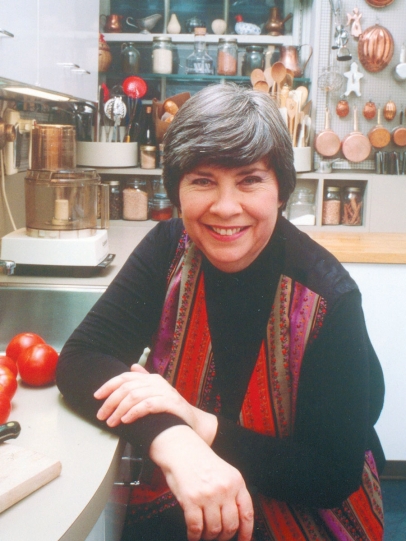Jean Anderson Adds More to Our Bookshelves
Instead of hawking her books on home shopping channels or seeking fame on Food TV, Jean Anderson has achieved the undisputed status as grand dame of North Carolina cookbook writing by letting her more than 20 volumes do the talking. The quality of the Chapel Hill author’s collection has been affirmed by a career’s worth full of well-deserved prizes from the most discerning culinary organizations.
Her newest collection, Crisps, Cobblers, Custards & Creams, arriving on store shelves in April, has all the markers of another big hit.
The book’s premise is that crisps, cobblers, custards and creams all fall into the general and particularly delicious category of puddings. You’ll find a handful of recipes that Anderson, a self-described child of World War II, has made since early recollections of growing up in Raleigh. She affectionately includes many from her mother’s foot-long metal recipe file, including ones that served as rewards when she brought home a good report card or performed especially well at a piano lesson.
The book’s scope also provides Anderson an opportunity to spotlight contributions from some of our region’s most outstanding chefs and cookbook writers. Among those especially familiar to Edible Piedmont readers are Sandra Gutierrez, Moreton Neal, Bill Smith and Andrea Weigl.
Because of her tight schedule, Anderson agreed to this interview in a question-and-answer format. We provided a range of questions for her consideration and share the best of the bunch with you here. Visit her website, www.jeanandersoncooks.com, to check for spring book signing events.
Edible Piedmont (EP): You’ve written more than 20 cookbooks covering a vast scope of culinary topics. To what do you attribute your continuing success?
Jean Anderson (JA): I’m a professional, someone with a solid background in nutrition and food chemistry (BS, Cornell, this country’s top nutrition school). I know what works, who creates new recipes or new riffs, who tests each recipe carefully — several times, if needed, until I know it’s fail-safe.
Moreover, I worked for many years in New York City as a magazine editor, which launched me as a freelance food and travel writer. Of course, my MS from the Columbia Graduate School of Journalism and winning its top honor — The Pulitzer Traveling Scholarship and the year abroad it gave — amounted to “several legs up.” Not least, I have won six “cookbook Oscars” (Tastemaker, International Association of Culinary Professions, James Beard Foundation) and I am a member of the James Beard Cookbook Hall of Fame.
EP: For many readers, this book will expand their notion of what constitutes a pudding, including cobblers and crisps. Have you always seen it this way, or was it a revelation for you as well?
JA: For me, “puddings” was always a broad category that included everything from gelatin whips and sponges to crisps, cobblers, crumbles, roly-polys, duffs, to mousses and soufflés and floating island and Bavarois to you name it. My mother made them all. I also think that the Raleigh of my youth also lumped all of these desserts into the pudding category.
EP: The collection is especially appealing as an affectionate tribute to your mother. How much impact did her evident love of cooking influence your career and your passion for being a lifelong learner?
JA: Two things you should know about my mother: She grew up in Illinois (around the corner, it turns out, from Adlai Stevenson). She was an academic, a human physiology professor at the University of Wisconsin before she married my father (he also was academic, a professor of plant physiology who became UNC Dean of the Graduate School, then VP in charge of Academic Studies working closely with the late Bill Friday). So cooking with my mother was like attending a junior CIA because she explained everything in detail, the Why’s of cooking as well as the How’s.
I’ve always had enormous curiosity as well as an intense eagerness to learn — something my mother instilled in me as we cooked together. Her kitchen “lessons” weren’t just about cooking. She’d fill me in on world history, tell me what was happening in the world of music, literature and art at the same time wars were being waged.
Mother would also relate stories of her early married life in Vienna where my father was teaching (in German) and where my older brother was born. She’d tell me about her days at Wellesley and the Yankee foods she learned to love; she’d tell me about her own mother’s recipes, her friends’ recipes. Mother was an inveterate recipe collector and I have her card file to prove it.
EP: Some recipes include ingredients that were not common in your mother’s day — your substitute of intensely favored dried cranberries for fresh, for example, and what appears to be a great satisfaction in the flavor and performance of almond milk. How have the increased availability of once hard-to-find ingredients, and environmental sensitivities that limit some people’s diets (ie, your gluten-free granola and streusel toppings) affected the way you cook and develop recipes?
JA: As a culinary professional, it is my job to keep up with what’s going on in the food world and lend a hand to those who have particular food allergies, intolerances and sensitivities. I, myself, am allergic to oysters, cannot even look at them, so I feel for those to whom milk, wheat, eggs, etc. are off limits.
EP: Your research library of cookbooks must be massive. Do you know about how many volumes you have? How do you organize your cookbooks? Can you share suggestions for people who want to create a strong personal library, including tips like collecting community cookbooks at library sales or from other resources?
JA: At least 1,000. When I relocated here after eons in New York City, I donated 60 cartons of cookbooks to The Hudson Guild (a charitable organization) only to discover that Bonnie Slotnik had bought nearly all of them and opened a used-cookbook store in the bowels of the Village. I organize cookbooks by subject — French, Italian, Chinese, Southern, Basic, etc. — but that’s not always practical because some books are short and others tall, sometimes too tall for the shelf.
Whenever, wherever I travel, at home or abroad, I head for the local bookstore and peruse the community fundraisers. I am looking for cookbooks with a sense of time and place — Charleston Receipts is the gold standard. Unfortunately the “packagers” now publishing local fundraisers dish up the same polyglot recipe assortment. If I am in Natchez, Mississippi, I am not looking for lasagna recipes or beef stroganoff or haggis. I am looking for what Natchez eats. I have never bought any cookbooks at library sales, but surely they’re a good source.
My advice: Buy what interests you. Avoid “celebrity” cookbooks that brim with recycled recipes and may have been “ghosted.” I have seen “celebrity authors” on TV who clearly had no clue what’s inside the cookbooks they’re said to have written. And they weren’t even embarrassed! I was horrified.





